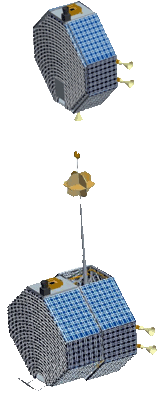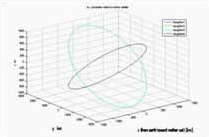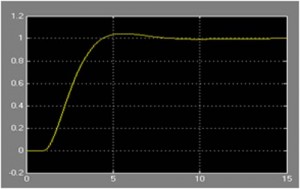Year 2009
Brookman Orly, Podolsky Tatyana, Azar Elad, Ben-Yaakov Ohad, Fligelman Eli , Ben Meleh David, Kfir Rafi
Faculty of Aerospace Engineering, Technion, Israel
Dr. Alex Kogan
Asher Space Research Institute, Technion, Israel
 A formation of a mother satellite and 4 daughter NANO-satellites in near- GEO will provide permanent access to positioning and precise timing service within the Middle East region.
A formation of a mother satellite and 4 daughter NANO-satellites in near- GEO will provide permanent access to positioning and precise timing service within the Middle East region.
Daughters relay mother’s signals to the user thus providing a user with a set of pseudo-range data.
The daughters (<9 kg each) will be built from ‘on the shelf’ components.
All satellites will be delivered in orbit in one launch.
 Daughters form a ~ 1000 km large, non-degenerating tetrahedron whereas their orbits obey International Regulations and stay within the allocated slot on GEO.
Daughters form a ~ 1000 km large, non-degenerating tetrahedron whereas their orbits obey International Regulations and stay within the allocated slot on GEO.
Perturbations make the semi major axis drift and the orbital plane rotate. Orbital correction are required in order to keep daughters’ orbits in slot.
The amount of fuel required : 67 gram/year .
 High-precision estimates of relative positions of satellites are necessary for accurate terminal users’ positioning . Laser range meter and star tracker onboard the mother sat and corner retro reflectors onboard every daughter provide required navigation data. Kalman filtering assures STD of relative position estimation errors >3 cm in each axis.
High-precision estimates of relative positions of satellites are necessary for accurate terminal users’ positioning . Laser range meter and star tracker onboard the mother sat and corner retro reflectors onboard every daughter provide required navigation data. Kalman filtering assures STD of relative position estimation errors >3 cm in each axis.
 The satellites coordinates arrive to a users’ terminal with 3s noise up to 10 cm. This noise affects the error of the terminal user positioning (the output error).
The satellites coordinates arrive to a users’ terminal with 3s noise up to 10 cm. This noise affects the error of the terminal user positioning (the output error).
These errors have been estimated with the Monte-Carlo method.
They are proven to be less than 10 m.
 Finding the angular position in which the received power of the on-ground beacon is maximum.
Finding the angular position in which the received power of the on-ground beacon is maximum.
The pitch loop performance: RT:2.63 sec,ST:2.89 sec ,OT: 4.8 %